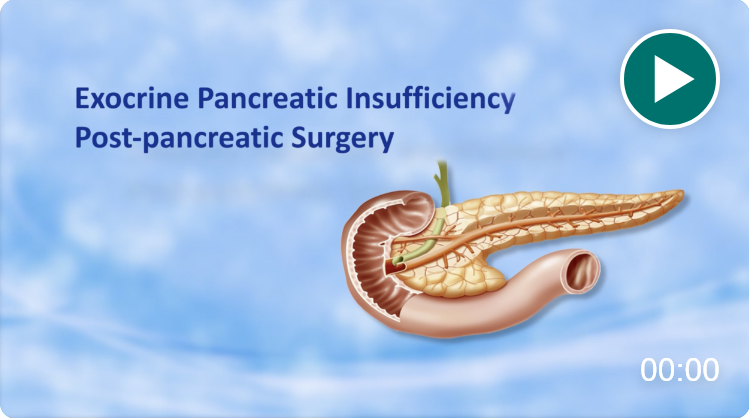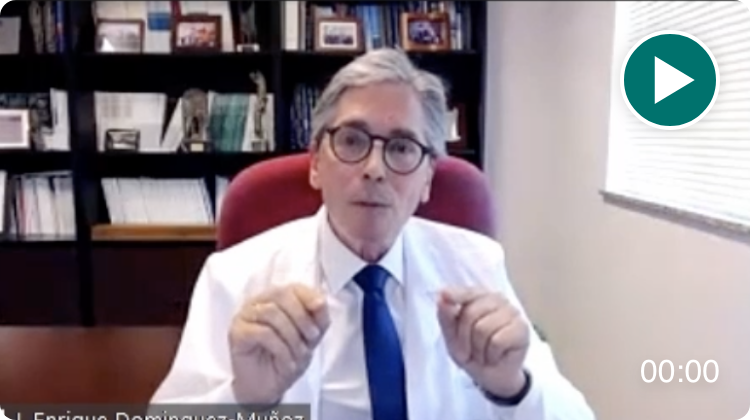
EPI Education
Take a deep dive into EPI and learn from experts in the field.
About EPI: EPI pathogenesis, symptoms, and diagnosis
Etiologies of EPI: Recognize EPI and the barriers to diagnosis
Management of EPI: Key information for managing EPI
Case Studies: Experts present case-based narratives on EPI
Select one or more filters below to explore topic-specific resources.
Transcript
Hello. I’m Dr. Jodie Barkin- Associate Professor of Clinical Medicine at the University of Miami in Miami Florida and Associate Medical Director of the University of Miami Pancreas Center. Today I am going to discuss with you the case of a 63-year-old man with a history of recurrent acute pancreatitis secondary to alcohol, with chronic alcohol and smoking intake. The patient presented to your clinic with chronic, dull epigastric pain, which intensified post-prandially. He also experienced bloating and unintentional weight loss. And in addition, he notes changes in the frequency and the consistency of his bowel movements. Laboratory tests showed that he had vitamin D deficiency, as well as low fecal elastase at 34 μg/g, consistent with exocrine pancreatic insufficiency, often referred to as EPI. The CT scan showed chronic pancreatitis changes noted by parenchymal calcifications, parenchymal atrophy and pancreatic ductal dilatation. You make a diagnosis of chronic pancreatitis with exocrine insufficiency. The patient is then started on Pancreatic Enzyme Replacement Therapy, or PERT and vitamin D replacement. He remains in an active imaging screening program for pancreatic cancer and is following with endocrinology for the management of his concomitant diabetes. So let’s review the etiology and risk factors for EPI in patients with Chronic Pancreatitis.
Chronic pancreatitis is an inflammatory syndrome involving recurrent or sustained injury to the pancreas. The exocrine pancreas is responsible for the production of digestive enzymes including lipases, amylases, and proteases, as well as bicarbonate secretion. And the pancreas on average produces about 720k units of lipase per meal. Chronic pancreatitis is caused by hereditary and environmental factors. Chronic ongoing inflammation or recurrent inflammatory episodes may eventually lead to fibrosis of the gland. Acinar cells are responsible for the production of digestive enzymes and are destroyed as a result of this immune mediated cascade. This sustained pancreatic injury, in combination with potential pancreatic ductal obstruction and decreased bicarbonate production, reduces the production and delivery of digestive enzymes making chronic pancreatitis a major cause of exocrine pancreatic insufficiency. Fat malabsorption typically manifests after a patient loses 90% of their exocrine function. And EPI leads to diarrhea, steatorrhea, maldigestion of food, and associated symptoms such as weight loss, and fat-soluble vitamin deficiencies.
The pooled prevalence of Chronic Pancreatitis is estimated to be 36.9-41.8 per 100,000 persons. Men and women experience varied susceptibility to these risk factors, with most cases of chronic pancreatitis in men being alcohol related, whereas most cases of chronic pancreatitis in women are found to be idiopathic. The prevalence of EPI increases with the duration of disease of Chronic Pancreatitis, starting first at 6-22% at the time of diagnosis, and increasing over time to 28% after 5 years post diagnosis. And then rising to 50% in patients that are approximately 12 years post chronic pancreatitis diagnosis. And therefore the probability of developing EPI increases with disease duration of Chronic Pancreatitis. And it’s therefore recommended to monitor your patients for the development of the signs and symptoms of EPI with screening for this condition at regular intervals with additional testing when indicated. Thank you so much for joining me today on this educational activity about exocrine pancreatic insufficiency or EPI in chronic pancreatitis.

Many Faces of EPI—Chronic Pancreatitis
Review the etiology and risk factors of EPI in patients with chronic pancreatitis.

Take an immersive journey into the physiology of the exocrine pancreas and the pathophysiology of EPI.

















